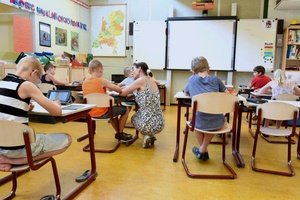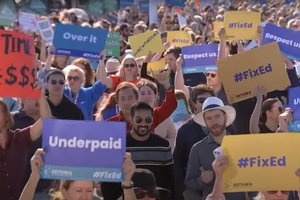A parent comes to you and you try to explain that their child hurt another kid, refused to join in, punched a teacher, broke a window, swore, and screamed.
They cry and you feel like crying, too.
They are desperate for their child to be OK at school.
You try your best to say all children have these moments when they are out of control, they are all learning, they are all building skills in ‘getting along’.
But you know there is more to this.
You know the environment in our schools is not the best it could be.
It’s too busy, there are too many kids in the room, and not enough staff to help ‘calm the storm’ of little people’s feelings.
One behaviour at a time we see a picture emerge of a specific child, and then a disorder, learning difficulty, trauma, dysregulation, or none of those, or all.
The tears flow, you try to placate, you listen, you make a strategy for next time, and you provide the ‘adjustments’ within your capacity.
They are only what your principal can offer, an integration aide for an hour if one is available, a quiet corner, a soft toy, a differentiated learning activity.
But you are still left alone at 3am going over what else you can do.
Of course, you go over your differentiation and behaviour management strategies endlessly with your teaching colleagues, your partner, until they don’t want to listen anymore.
You shed tears each afternoon in the car on the way home, thinking ‘I can’t do this anymore’.
What we need is unattainable.
We know exactly what the child needs, what all children need to learn, but we quickly learn that the help that we need is tied in red tape, forms and marginalisation of families with children with additional needs.
The Education Department of Victoria states that 15 per cent of our school children are identified as learners with disability who require some level of ‘reasonable adjustment’ in the classroom.
‘Some level’, and ‘reasonable adjustment’ don’t really do justice to the needs of our children, and certainly don’t address the growing behavioural disorders and concerns in our classrooms.
They assume that principals and classroom teachers have the resources and capacity for these adjustments without identifying what makes a difference to the foundation of these adjustments.
We know what works and we need our communities to stand up and let our governments know that the chronic underfunding of our education system is to blame.
We don’t have the resources, capacity, teaching staff, or budgets to educate the children in our care because we don’t have the resources, capacity, staff, or budgets to set a basic level of care.
We have had over a decade of reports that outline the chronic underfunding of Victorian schools, the shortage of teachers, and a continued suggestion that special schools will be phased out.
How much more can you take away?
We know what our students need; small class sizes, buildings that are not rotting, and staff, including learning support teachers for every student who needs one, teachers with special education qualifications and schools with consistent access to professional intervention staff including psychologist and occupational therapists.
We are heading for an education system that doesn’t actually support any of our learners.
As a teacher I feel like I am in on the pretence.
It feels like a con.
It’s time we stop saying we have an education system that works because ours doesn’t even half work.
It isn’t sustainable and it isn’t even safe much of the time.
* The author's name has been changed for privacy purposes.














